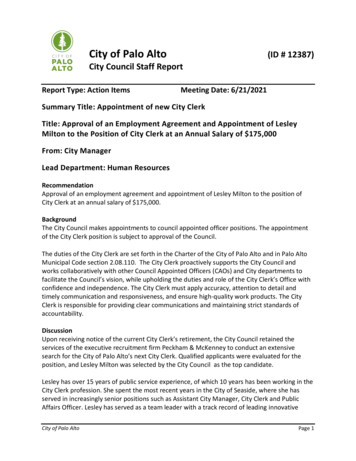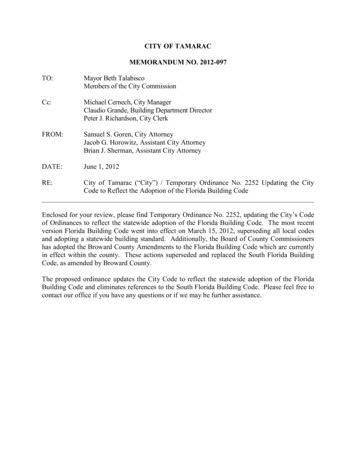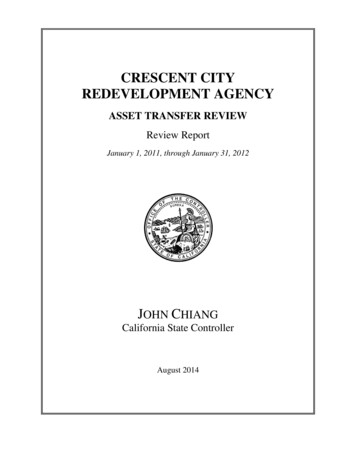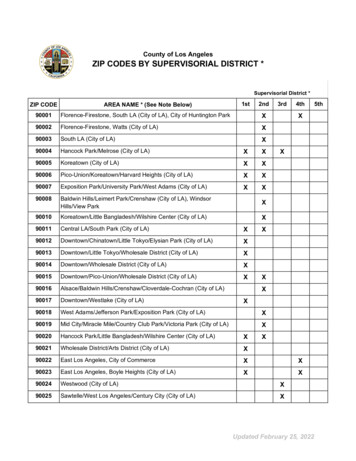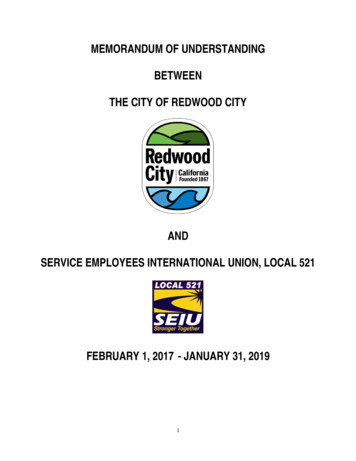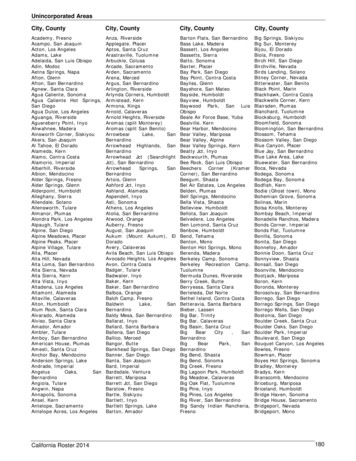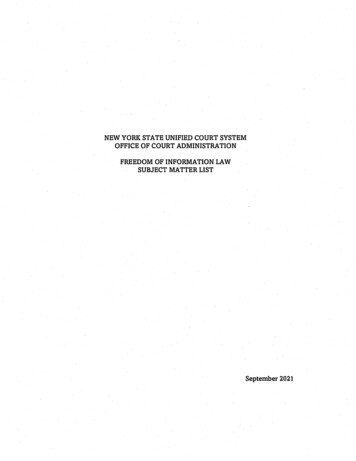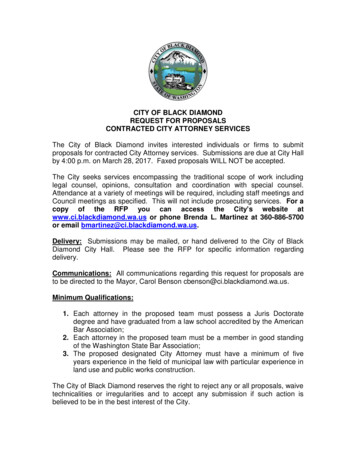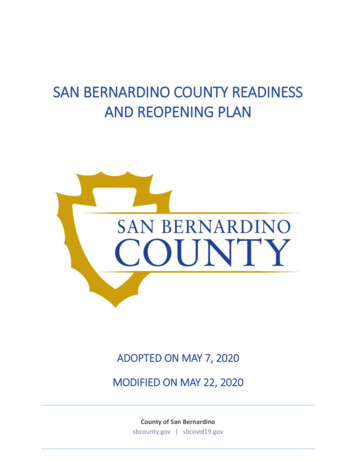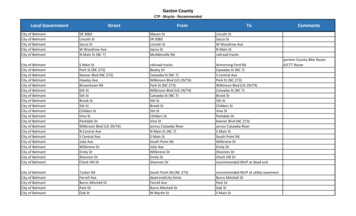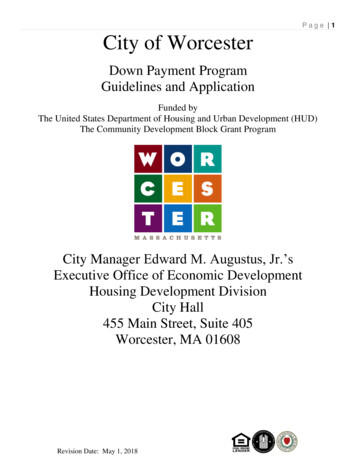
Transcription
Page 1City of WorcesterDown Payment ProgramGuidelines and ApplicationFunded byThe United States Department of Housing and Urban Development (HUD)The Community Development Block Grant ProgramCity Manager Edward M. Augustus, Jr.’sExecutive Office of Economic DevelopmentHousing Development DivisionCity Hall455 Main Street, Suite 405Worcester, MA 01608Revision Date: May 1, 2018
Page 2TABLE OF CONTENTS1. PROGRAM DESCRIPTIONPage 32. HOME BUYER ELIGIBILITYPage 33. PROPERTY ELIGIBILITYPage 64. MAXIMUM PURCHASE PRICEPage 105. FIRST MORTGAGE REQUIREMENTSPage 106. THE PROGRAM GRANTPage 117. THE APPLICATION PROCESSPage 138. HOME SELECTION AND PROGRAM DISCLOSURESPage 149. PROGRAM GRANT UNDERWRITING AND APPROVALPage 1510. CLOSING ESCROWPage 1611. POST-PURCHASE: ANNUAL COMPLIANCE MONITORINGPage 1712. PAYMENT OF THE PROGRAM GRANTPage 1713. ADMINISTRATIVE REQUIREMENTSPage 1714. DOWN PAYMENT APPLICATIONPage 20Revision Date: May 1, 2018
Page 31. PROGRAM DESCRIPTIONThe City of Worcester, hereinafter referred to as the “City,” has established the Down Payment ProgramGuidelines described herein (the “Program”) to provide assistance to individuals and households who areeligible first-time home buyers for the purchase of homes located within the Worcester city limits, as describedin Section 3.1.A. The Program provides this assistance in the form of a conditional grant agreement andaffordable housing restriction. The Program grant funds may be used toward interest rate buy down or to pay upto 50 percent of the down payment required by the Primary Lender for the purchase.The Program will be administered by City Manager Edward M. Augustus, Jr.’s Executive Office of EconomicDevelopment, Housing Development Division (the “Division”).The Division offers financial assistance to eligible low to moderate income first-time homebuyers through theDivision’s Down Payment Program. Under the program, eligible down payment is paid for with funds availableunder the U.S. Department of Housing & Urban Development’s Community Development Block GrantProgram (CDBG) program.1Eligible households must document that they have the funds necessary for down payment and/or interestrate buy down as required by the Primary Lender.CDBG assistance funds will be reimbursed after the closing of the approved transaction.2. HOME BUYER ELIGIBILITY2.1 HOUSEHOLD INCOME LIMITSApplicants’ household incomes may not exceed 80% of City of Worcester’s Area Median Income (AMI),adjusted for household size, as published by HUD, and shown in the FY 2018 Income Limits table below. Inorder to qualify for a Program grant to be funded with CDBG funds, the applicants’ household income may notexceed the HUD “low” (80%) income limit for Worcester, MA HUD Metro FMR Area. Applicants must certifyand provide acceptable documentation that their gross household incomes do not exceed the income limits. Theincome limits in place at the time of application submittal will apply when determining applicant’s eligibility.House Hold Size1234567880% of Area Median Income Limits adjusted for household size(Effective as of 04/1/2018) 52,850 60,400 67,950 75,450 81,500 87,550 93,600 99,600124 CFR 570.201(n), 24 CFR 570.208(a), 24 CFR ion Date: May 1, 2018
Page 42.2 DETERMINING HOUSEHOLD INCOMEThe applicant’s projected gross annual household income will be used to determine the applicant’s incomeeligibility for the Program. The Division will use the HUD “Part 5” method, as set forth in 24 CFR Part 5.609and described below, to determine and verify applicant’s gross annual household income. The gross annualhousehold income determined by the Division may or may not equal the household income calculated by thefirst mortgage lender when qualifying the household for the first mortgage.The gross annual household income determined by the Division, not that calculated by the first mortgage lender,shall prevail in determining the applicant’s eligibility for the program and for all Program grant underwritingpurposes, including housing cost ratios. The first mortgage lender may use a different method than the Divisionto calculate the applicant’s income or assets. All income sources of all adults in the applicant’s household willbe verified by the Division by reviewing and documenting tax returns, copies of wage receipts (paycheck stubs),retirement and/or benefit checks, bank statements and third-party verification of employment, using forms sentto employers.All documentation shall be no more than 90 days old, from the date of submission and will be kept in theapplicant file and held in strict confidence.Household Income Definition:The Program uses the definition of household income in 24 CFR Part 5.609 (also known as the “Part 5” or“Section 8” method) to determine applicants’ income eligibility for the program: “the gross amount of income,[before tax or other deductions] of all adult household members [18 years of age or older] that is anticipated tobe received during the coming 12-month period.” Program staff follows HUD’s Community Planning andDevelopment's Income Eligibility Calculator (https://www.hudexchange.info/incomecalculator/), whichexplains the Part 5 method of calculating household income. This method defines types of income and assets tobe included or not included in the household’s income calculation. Income from assets is, however, recognizedas part of annual income under HUD’s Part 5 definition of income.Special consideration is given to income earned by minors, live-in aides, persons with disabilities, temporarilyand permanently absent family members, and adult students living away from home.Household Asset Definition:An asset is a cash or non-cash item that can be converted to cash. The value of necessary items such as furnitureand automobiles are not included. Assets will include the total of funds to be used for down payment andreserves and must be reported at the time of reservation application.An asset’s cash value is the market value less reasonable expenses required to convert the asset to cash,including: penalties or fees for converting financial holdings and costs for selling real property. The cash value(rather than the market value) of an item is counted as an asset. The income earned, such as interest on a savingsaccount, is counted as annual income, not the asset value.The “OneCPD Calculator” describes the Part 5 method and provides the list of income and asset exclusions andis available online at HUD’s ousing/library/modelguides/1780.pdf.Revision Date: May 1, 2018
Page 5The borrower’s total household liquid assets cannot exceed more than of 20% or more of the purchaseprice, pre-paids and closing costs totaling less than 75,000 (either cash or gift) who meet all otherguidelines, qualify for the assistance.Borrowers with assets greater than 75,000 at the time of application do not qualify for the Program.2.3 FIRST TIME HOME BUYER STATUSThe Program uses the definition from HUD of a “first-time home buyer” and verifies utilizing the following, butnot limited to, documentation of first-time home buyer status with tax returns and other documents (i.e., leases,etc.) must be submitted with the application in order to verify first time home buyer status.“First-Time home buyer” means an individual or individuals or an individual and his or her spouse who havenot owned a home during the three-year period before the purchase of a home with subsidy assistance, exceptthat the following individual or individuals may not be excluded from consideration as a first-time home buyerunder this definition:a) A displaced homemaker who, while a homemaker, owned a home with his or her spouse or resided in ahome owned by the spouse. A displaced homemaker is an adult who has not, within the preceding twoyears, worked on a full-time basis as a member of the labor force for a consecutive twelve-month periodand who has been unemployed or underemployed, experienced difficulty in obtaining or upgradingemployment and worked primarily without remuneration to care for his or her home and family;b) b) A single parent who, while married, owned a home with his or her spouse or resided in a home ownedby the spouse. A single parent is an individual who is unmarried or legally separated from a spouse andhas one or more minor children for whom the individual has custody or joint custody or is pregnant; orc) An individual or individuals who owns or owned, as a principal residence during the three-year periodbefore the purchase of a home with assistance, a dwelling unit whose structure is: Not permanently affixed to a permanent foundation in accordance with local or stateregulations; or Not in compliance with state, local, or model building codes and cannot be brought intocompliance with such codes for less than the cost of constructing a permanent structure.As set forth in subsection c) above, applicants may own a manufactured or mobile home not on a permanentfoundation and not affixed to real property also owned by the applicant; however they must sell themanufactured home prior to closing escrow on the Program-assisted home purchase and must utilize their netproceeds of the sale, to the extent possible, toward their down-payment on the new home purchase.2.4 HOME BUYER EDUCATIONBuying a home can be one of the most confusing and complicated financial transactions of the prospectivebuyer’s life. Home buyer education classes from a HUD-certified or a Massachusetts HomeownershipCollaborative – accredited agency can help prospective buyers avoid costly mistakes, and can often help thebuyer avoid foreclosure or default by providing education about financing, grants, and budgeting prior to thepurchase. Studies have shown that first-time home buyers who have attended HUD-certified home buyereducation classes have a greater ability to handle problems that often occur with homeownership.Applicants must attend complete a HUD-certified a Massachusetts Homeownership accredited housingeducation workshop prior to receiving written approval for a Program grant. The home buyer education classRevision Date: May 1, 2018
Page 6will cover the following topics, at a minimum: preparing for homeownership; available financing; creditanalysis; grant closing; homeownership responsibilities; home maintenance; the impact of refinancing, andgrant servicing. The applicant must attend and receive a certificate of completion from either a HUD-certifiedor a Massachusetts Homeownership Collaborative -accredited first time home buyer course, usually consistingof eight hours of instruction, and provide the Program staff with a copy of the certificate prior to close ofescrow. The local providers of home buyer classes that meet Program requirements:Neighborhood Assistance Corporation of America (NACA)Address: 64 Madison Street, Worcester MA 01608Phone: 617-250-6222Website: www.naca.comNeighborWorks HomeOwnership Center of Central MassachusettsAddress: 138 Green Street, suite 4, Worcester, MA 01604Phone: 508-791-2170Website: www.hoccm.orgRCAP SolutionsHousing and Consumer Education CenterAddress: 12 East Worcester Street, Worcester, MA 01604Phone: 508-769-3481Website: www.rcapsolutions.org3. PROPERTY ELIGIBILITY3.1 LOCATION AND CHARACTERISTICSA. Homes must be located within the City of Worcester city limits.B. Homes must have been vacant or owner-occupied (by the seller’s household only) for the entirethree-month period prior to the date of the purchase offer, and must continue to be vacant or owneroccupied through close of escrow. Tenant-occupied homes are not eligible for purchase, unless thetenant is purchasing the home. See Section 3.3 below for additional details.C. Homes may be new or resale single, two, three and four-family homes, town homes, orcondominiums. Market-rate or affordable HOME-assisted, or a property on the Mass Access Registry,www.massaccesshousingregistry.org, may be purchased, however there is generally a waiting list for theopportunity to buy a subsidy-assisted home.If the home proposed for purchase is new (i.e., not previously sold to a home buyer), the foundationmust have been poured prior to seller’s receipt of the buyer’s purchase offer. Space rents and/orcommon interest dues will be included in buyers’ housing costs for Program underwriting purposes.D. All homes must be in compliance with State and local building, zoning, and health and safety codesand ordinances.E. If the home is located within a 100-year flood zone, the buyer will be required to obtain and maintaina flood insurance policy, with an initial term not less than one year prepaid in escrow, and provide anendorsement naming the City of Worcester as additional insured, prior to funding of the Program grant.Revision Date: May 1, 2018
Page 73.2 CONDITION OF THE HOMEHomes must meet all applicable state and city zoning, building, housing and health and safety codes prior toclose of escrow in order to be eligible for Program assistance. Older homes that are legal non-conforming mustmeet the zoning codes that were in effect at the time they were constructed, as well as current applicablebuilding and health and safety codes as required by the Division Inspectional Services and Building and Code.If any subsequent construction or remodeling was done to the home by the seller or a prior owner, it must be incompliance with the codes in effect at the time the work was done, must have passed city building inspection,and there may not be any current code violations that may present a health and safety hazard (i.e., constructionwithout permits, including garage conversions, additions, encroachments, etc.). New homes are eligible forpurchase once a Certificate of Occupancy has been issued by the Division Inspectional Services and Buildingand Code. Resale homes require inspection by the Division and by a certified Home Inspector, as set forthbelow.A. Resale Homes: Inspection and Determining Need for Repairs:Once the applicant has identified a potential home to purchase, and prior to a commitment of Program funds,the following steps must be taken for the home to be eligible for purchase under the Program:i. The Division’s Rehabilitation Specialist will inspect the home to identify any housing, building, and/or healthand safety code deficiencies to be corrected in order for the home to be eligible for purchase. The Specialistwill provide a recommended list of work items, if any, needed for the home to pass inspection. If the homerequires substantial rehabilitation (more than 10,000 of repair work) to meet codes, or if the home hashealth and safety and/or building code violations (such as un-permitted additions or garage conversions), thehome will be considered substandard and determined not to be eligible for Program assistance unless all ofthe violations are corrected by the seller and pass Division inspection prior to applicant’s submittal of apurchase and sales agreement.ii. The prospective buyer must also hire a certified home inspector of their own choosing to inspect the home,and provide a copy of the inspection report to the Division staff. The home buyer and their real estate brokeror agent may negotiate with the seller regarding repair costs. Homes requiring repairs and correctionsestimated to cost in excess of 10,000 will not be eligible for Program assistance, unless the required repairsare demonstrated to be addressed with a purchase and rehabilitation loan program.Smoke detectors must beinstalled by the seller if there are none in place and obtain a Smoke Certificate by the appropriate authority.iii. A current pest inspection must be performed by a licensed pest inspector of applicant’s choosing, and anyrequired treatments must be completed, and a clear inspection report provided to escrow. The Division willencourage each home buyer to secure a homeowner’s warranty policy as part of the purchase of a resalehome.iv. HUD’s environmental review regulations now need for radon testing and mitigation in their HUD-assistedactivities. HUD regulations at 24 CFR 50.3(i) and 58.5(i)(2) require all property to be free of contaminationwhere a hazard could affect the health and safety of occupants or conflict with the intended use of theproperty. Section 50.3(i) states that “It is HUD policy that all property proposed for use in HUD programsbe free of hazardous materials, contamination, toxic chemicals and gasses, and radioactive substances,where a hazard could affect the health and safety of occupants or conflict with the intended utilization of theproperty” By far the most frequently occurring radioactive substance that threatens HUD-assisteddevelopment is radon gas.B. Post-purchase Rehabilitation Assistance:Homes purchased with Program assistance may be eligible for the City Lead-Based Paint Hazard programfunding after the date of purchase.Revision Date: May 1, 2018
Page 8C. Home Size:The home shall be not larger than necessary to meet the needs of the home buyer household, withoutovercrowding. Generally, this means not more than two persons per bedroom plus one, and not less than oneperson per bedroom. Exceptions to the maximum household size limit may be made by the Division uponrequest to accommodate a large household already living together in a home with an equal or fewer number ofbedrooms, but two or more households not currently living together may not use this exception in order topurchase a home together.D. Lead-Based Paint Hazards:All homes built prior to 1978 must pass a visual lead-based paint hazard inspection in order to qualify forpurchase with Program assistance. If the home was built prior to 1978, and does not pass the Division’s visualassessment, it may require a certified lead-based paint inspector or risk assessor to test all painted, shellacked,or varnished surfaces to determine the presence or absence of lead. If the test results indicate that unstable leadis present and corrective work is needed, such as encapsulation with new paint, the work must be performed bycontractors licensed to do lead-based paint hazard reduction and/or abatement, using work safe methods. If suchwork is performed, the testing firm will test again after the work is done and provide a clearance letter once theresults indicate no hazards are present.The following steps must be taken regarding potential lead hazards:i. Notification: Program application packages will include the most recent copy of the EPA pamphlet “Protectyour family From Lead in Your Home” (See Appendix Protect your family from Lead in your home andconfirmation of lead pamphlet). Applicants will be required to read the pamphlet and sign a certification thatthey have read it prior to receiving pre-approval for Program assistance.ii. Disclosure: Sellers of homes built prior to 1978 must provide prospective buyers with the HUD noticeentitled “Seller’s Lead-based Paint Disclosure” prior to accepting a purchase offer from the prospectivebuyer. Buyers shall not submit a purchase offer until they have received this disclosure from the seller orseller’s agent.iii.Inspections: The Inspector shall conduct a conduct a surface by surface testing of all painted, shellacked, orvarnished surfaces to determine the presence or absence of lead in the home in order to identify leadhazards. All lead hazards must be stabilized in accordance with CFR 35.1330 (a) and (b); and a clearanceshall be made in accordance with CFR 35.1340.iv. Mitigation: If stabilization is required, the Division must approve the contractor selected to perform thework in order to assure that only those certified to stabilize lead paint are allowed to perform the mitigation.v. Confirmation of Property Eligibility: Once a pre-approved Program applicant has provided all the requireddocumentation of a home’s eligibility and all required inspections have been completed, the Division will: 1)confirm that the home is within the Worcester city limits, 2) review each proposed home to ensure that it meetsall eligibility criteria, and 3) place a Down Payment Assistance Checklist / File Review.Requirements for Projects Receiving Rehabilitation Assistance Up to and Including 5,000 per UnitProjects where the level of rehabilitation assistance is less than or equal to 5,000 per unit must meet thefollowing requirements: The goal is to “do no harm.” Therefore all work must be conducted using lead safe workpractices. Workers must be trained in lead safe work practices (see the attached exhibits). Lead Hazard Evaluation. Paint testing must be conducted to identify lead-based paint on paintedsurfaces that will be disturbed or replaced. Alternatively, grantees may presume that thesesurfaces contain lead-based paint.Lead Hazard Reduction. Grantees must repair all paint that will be disturbed during rehabilitation,unless such paint is found not to be lead-based paint. – If lead-based paint is detected or presumed,Revision Date: May 1, 2018
Page 9safe work practices must be used during rehabilitation. Clearance is required by a certified clearanceexaminer.Notices must be provided to owners and tenants: – The Lead Hazard Information pamphlet; – TheNotice of Evaluation (if paint testing is performed) or Notice of Presumption (if paint testing is notperformed); and – The Notice of Lead Hazard Reduction.In short, for rehabilitation projects where the level of assistance is less than or equal to 5,000 per unit, workersmust be trained in safe work practices, notices must be provided to owners and tenants, and clearance must beachieved.3.3 ANTI-DISPLACEMENT POLICY AND RELOCATION ASSISTANCEEligible homes are those that are currently owner-occupied or have been vacant for at least three months prior tothe buyer’s submittal of a written offer to purchase. A home is ineligible for Program assistance if its purchasewould result in the displacement of a tenant (i.e., anyone other than the seller’s household), whether or not thetenant is paying rent. The Program will NOT assist the purchase of any tenant-occupied homes or knowinglyassist buyers who cause tenant displacement, therefore is not anticipated that the implementation of theProgram will result in the displacement of any persons, households, or families. If a seller knowingly offers atenant-occupied home for sale to a Program-assisted buyer but fails to disclose the tenancy to the Program, andany federal or state agency later determines that relocation benefits are owed the tenant, the seller will be heldsolely responsible for the costs of compliance with federal and/or state relocation law, as applicable. Such costsare typically significant and can often exceed the amount of the Program grant; therefore tenant-occupiedhomes are excluded from the Program. The following Federal laws apply to any tenant displacement that mayoccur in association with use of federal funds for property acquisition: Uniform Relocation Assistance (URA) and Real Property Acquisition Policies Act of 1970 The federal URA and Real Property Acquisition Policies, as amended by the URA Amendmentsof 1987, apply to projects or programs funded in whole or part with federal funds, includingHUD funds such as HOME Program funds, which involve real property acquisition and causethe displacement of a person, regardless of income status. The implementing regulations in 49CFR Part 24 provide further requirements that the lead agency must follow to provide adequaterelocation assistance for displaced tenants. Section 104(d) of the Housing and CommunityDevelopment Act of 1974 Section 104 (d) requires the City, as a condition of receiving HUD funds, to certify that it isfollowing a residential anti-displacement plan and relocation assistance plan. Section 104(d) alsorequires relocation benefits to be provided to low-income persons who are physically oreconomically displaced as the result of a CDBG assisted project. The implementing regulationsfor Section 104(d) can be found in 24 CFR Part 570.4. MAXIMUM PURCHASE PRICEThe maximum purchase price of homes purchased with CDBG-funded Programs shall not exceed 95 percent ofthe median area purchase price for single family housing. In lieu of the limits provided by HUD, through theHOME and Housing Trust Fund Homeownership Sales Price Limits; the City of Worcester will work with theREALTOR Association of Central Massachusetts and the Massachusetts Real Estate Property Listing(MLS.com) to review, at minimum, on a semi- annual basis the listing and sale data.Revision Date: May 1, 2018
P a g e 105. FIRST MORTGAGE REQUIREMENTSPrior to obtaining a Program grant commitment from the City, a home buyer must provide a loan approval letterfor a first mortgage in the maximum amount the first mortgage lender is willing to loan the home buyer withinthe Program grant standards (i.e., rates, ratios, amortization schedule, and other minimum loan requirements).The program requires fair and competitive interest rates with no points being charged to the borrower. Theprogram encourages pricing concessions to qualified applicants whenever possible.5.1 UNDERWRITING STANDARDSFully documented first mortgages approved for funding by Neighborhood Assistance Corporation of AmericaMassHousing or Massachusetts Housing Partnership (MHP), FHA, the VA, or, or a large institutional lenderthat underwrites to MassHousing, Fannie Mae, Freddie Mac, VA or FHA standards, will be acceptable toestablish the applicant’s ability to make payments and dependability of income, in addition to the Program’sunderwriting standards explained below. Loans approved without full income documentation of themortgagor(s), often referred to as “no doc” or “stated income” loans, may not use to purchase a home with aProgram grant.In order to qualify for Program assistance, the applicant’s “front-end ratio” shall be not more than 31%. Thefront-end ratio is the percentage of a borrower’s gross monthly income (before income tax deductions) equal tothe total of the following monthly housing costs: required first mortgage payment (principal and interest),property taxes, property insurance, and homeowner association dues and/or mobile home space rent, if any.Ratios will be reviewed using the lender’s determination.The applicant’s “back-end ratio” shall not exceed 45%. The back-end ratio is the percentage of a borrower’sgross monthly income that would be required to cover the front-ratio costs (monthly housing costs), plus anyother mandatory monthly debt payments, such as: car loans, personal loans and credit cards, alimony or childsupport ordered by a court, and/or student loans.The city of Worcester will allow for Lenders utilizing MassHousing, Massachusetts Housing Partnershipor Neighborhood Assistance Corporation of America, primary and subordinate financing may go up to50% for the back end ratio. .5.2 INTEREST RATEThe first mortgage must be fully amortized and have a fixed interest rate for the entire term that does not exceedthe current market rate. No temporary interest rate buy-downs are permitted. Sub-prime rates, adjustable rates,interest-only options, and/or any type of negative amortization shall not be acceptable in the first mortgage.5.3 LOAN TERMThe first mortgage shall be fully amortized over the term of the loan and have a term “all due and payable” inno fewer than 30 years. There shall be no balloon payment requirements or prepayment penalties included in theterms of the first mortgage.5.4 ESCROW ACCOUNTRevision Date: May 1, 2018
P a g e 11All households will be required to have escrow accounts for the payment of property taxes, property insurance,and ground lease fees as required by the Program.6 THE PROGRAM GRANT6.1 MAXIMUM AMOUNT OF PROGRAM ASSISTANCEThe amount of Program assistance to a home buyer toward purchase of a home shall not exceed up to 5,000.00 of Direct Homeowner Assistance.Title I of the Housing and Community Development Act (HCDA) of 1974 was amended by the CranstonGonzalez National Affordable Housing Act, which became law on November 28, 1990. As a result, directhomeownership assistance was added as an eligible activity under Section 105(a) of the HCDA.Homeownership assistance is referenced at 24 CFR 570.201(n) of the regulations. This provision allows fordirect assistance to facilitate and expand homeownership for low- and moderate-income households inaccordance with Section 105(a). It is important to note, however, that the homeownership assistance providedunder 24 CFR 570.201(n) is limited exclusively to meeting the low- and moderate-income housing nationalobjective at 24 CFR 570.208(a)(3) or 24 CFR 570.483(b)(3). Under this authority, CDBG funds may be used to: Subsidize interest rates and mortgage principal amounts to make loan payments affordable, includingthe making of grants to reduce the effective interest rates charged on the loans. Low- or no-interestsubordinate loans can also be used to reduce overall loan repayment amounts and thereby make thepurchase price more affordable.Pay all or part of the premium on behalf of the homebuyer for mortgage insurance required upfront by aprivate mortgageePay up to 50 percent of the down payment required by the mortgagee for the purchase on behalf of thehomebuyer.6.2 NON-RECURRING CLOSING COSTSThe amount of assistance available to an applicant is capped at the maximum of 4,925. Closing costs whichmay be covered by this grant program are as follows: Appraisal Fees Credit report Title search Cost of Title Insurance Policy, including survey deletions Flood Certification fees Bank processing fees Closing Attorney’s fees Recording fees Some miscellaneous charges6.3 DETERMINING THE AMOUNT OF THE PROGRAM GRANTThe actual amount of a buyer’s Program grant shall be computed after the applicant has identified a home topurchase and ha
The Program uses the definition from HUD of a "first-time home buyer" and verifies utilizing the following, but not limited to, documentation of first-time home buyer status with tax returns and other documents (i.e., leases, etc.) must be submitted with the application in order to verify first time home buyer status.

